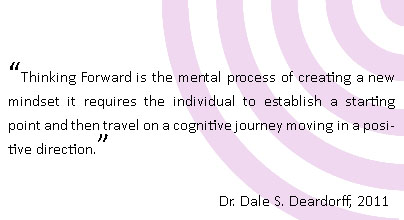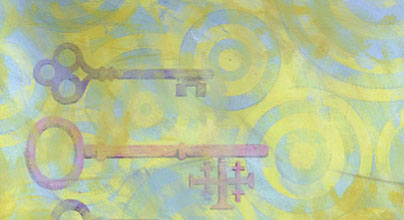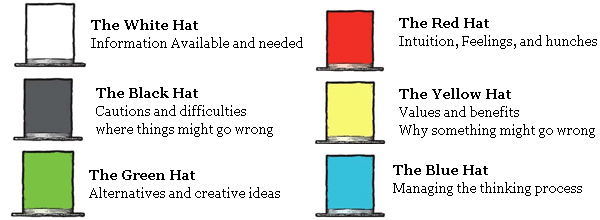


The de Bono Hats system (also known as "Six Hats" or "Six Thinking Hats") is a thinking tool for group discussion and individual thinking. Combined with the idea of parallel thinking which is associated with it, it provides a means for groups to think together more effectively, and a means to plan thinking processes in a detailed and cohesive way. The method is attributed to Dr. Edward de Bono and is the subject of his book, Six Thinking Hats.
Underlying Principles
The premise of the method is that the human brain thinks in a number of distinct ways which can be identified, deliberately accessed and hence planned for use in a structured way allowing one to develop strategies for thinking about particular issues. Dr de Bono identifies five distinct states in which the brain can be "sensitised". In each of these states the brain will identify and bring into conscious thought certain aspects of issues being considered (e.g. gut instinct, pessimistic judgment, neutral facts).
A compelling example presented is sensitivity to "mismatch" stimuli. This is presented as a valuable survival instinct, because, in the natural world, the thing that is out of the ordinary may well be dangerous. This state is identified as the root of negative judgment and critical thinking.
Six distinct states are identified and assigned a color:
- Information (White Hat) - considering purely what information is available, what are the facts? What do we know, what do we need to know?
- Emotions (Red Hat) - instinctive gut reaction or statements of emotional feeling
(but not any justification) - Logical Negative points judgment (Black Hat) - logic applied to identifying flaws or barriers, seeking mismatch
- Logical Positive points judgment (Yellow Hat) - logic applied to identifying benefits, seeking harmony
- Creativity (Green Hat) - statements of provocation and investigation, seeing where a thought goes
- Thinking (Blue Hat) - thinking about the thinking

Colored hats are used as metaphors for each state. Switching to a state is symbolized by the act of putting on a colored hat, either literally or metaphorically. These metaphors allow for more complete and elaborate segregation of the states than the preconceptions inherent in people's current language. All of these thinking hats help for thinking deeper The six thinking hats indicate problems and solutions about an idea or a product you might come up with. Furthermore, Dr de Bono asserts that these states are associated with distinct chemical states of the brain — however, no details or evidence of this are presented.
Parallel Thinking
In ordinary, unstructured thinking this process is unfocussed; the thinker leaps from critical thinking to neutrality to optimism and so on without structure or strategy. The Six Thinking Hats process attempts to introduce parallel thinking.
Many individuals are used to this and develop their own habits unconsciously. Sometimes these are effective, other times not. What is certain is that when thinking in a group these individual strategies will not tend to converge. As a result, discussion will tend not to converge. Due to the power of the ego and the identified predilection to black hat thinking in the majority of western culture, this can lead to very destructive meetings. Even with good courtesy and clear shared objectives in any collaborative thinking activity there is a natural tendency for "spaghetti thinking" where one person is thinking about the benefits while another considers the facts and so on.
The hats allow this to be avoided so that everyone together considers the problems, or the benefits, or the facts, reducing distractions and supporting cross pollination of thought. This is achieved because everyone will put on one hat, e.g., the white hat, together, then they will all put on the next hat together. In this way all present think in the same way at the same time. The only exception being the facilitator who will tend to keep the blue hat on all the time to make sure things progress effectively. The blue hat tends to be the outward-looking, leader/trail blazing hat that attracts the leaders of all groups.
Having identified the six states that can be accessed, distinct programs can be created, these are sequences of hats which encompass and structure the thinking process toward a distinct goal. A number of these are included in the materials provided to support the franchised training of the six hats method; however it is often necessary to adapt them to suit an individual purpose. Also, programs are often "emergent" which is to say that the group might plan the first few hats then the facilitator will see what seems to be the right way to go.
Sequences always begin and end with a blue hat; the group agrees together how they will think, then they do the thinking, then they evaluate the outcomes of that thinking and what they should do next. Sequences (and indeed hats) may be used by individuals working alone or in groups.
Expected Results:
- Understand your personal thinking style
- Creates new “Thinking-Together” communication style
- Recognize the thinking styles of others
- Learn to be a more strategic individual thinker
- Become a more creative and evaluative thinker
- Think smarter, not harder
- Understand why you think the way you do
- Learn to get "un-stuck" in your thinking
- Focus on your strengths, and identify your areas of opportunity
- Use the framework to maximize the time you spend thinking
- Understand the concept of parallel thinking
- Learn the six distinct thinking modes
- Practice thinking in each of these modes
- Learn to separate feelings from fact
- Lead more focused, productive meetings
- Learn how to manage the different styles of thinkers
- Identify what is holding you back in your meetings
- Channel the factors that impact thinking in a meeting: emotion, logic, creative, skeptic
- Learn to harness the collective thinking of your team
- Foster respect for the individual
- Create consensus in teams!
- Solve problems and develop innovative solutions
Training is conducted by a certified DBTS trainer or master trainer.
For more information about this workshop download the Six Hats Brochure![]()
For more information on cost and event booking, email RPLC

